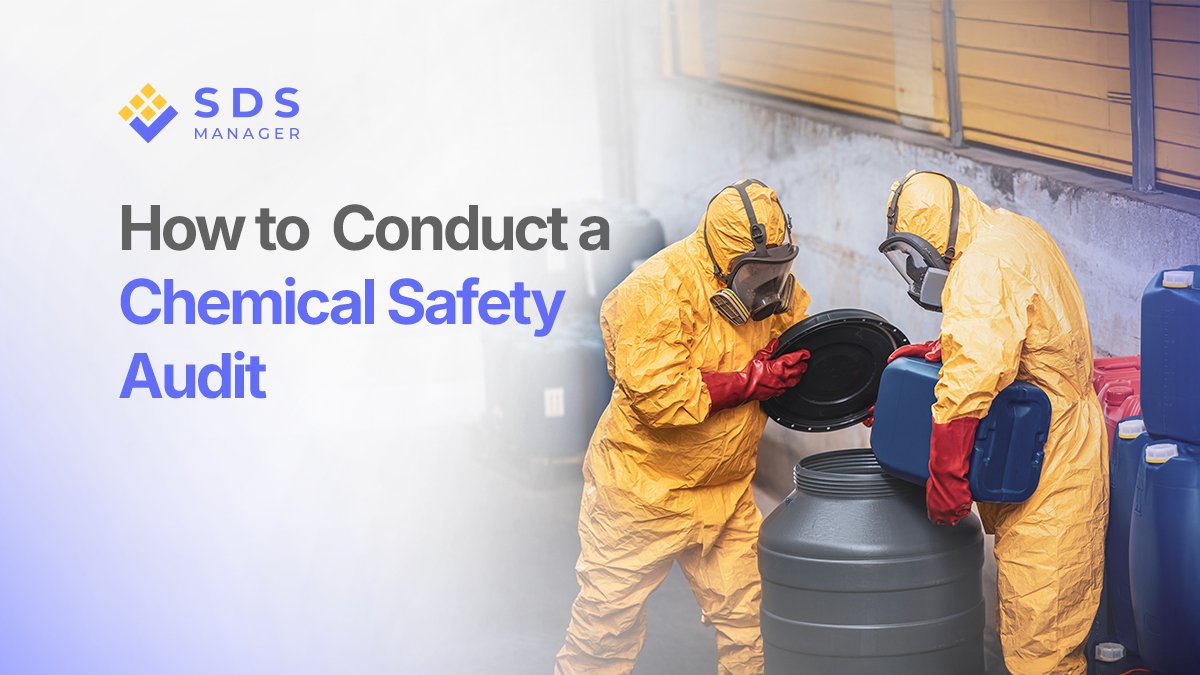

A chemical safety audit is a structured review of how chemicals are stored, used, and managed in the workplace. Its main aim is to protect workers and prevent chemical-related incidents such as fires, leaks, or exposure. Regular audits show that your company takes health and safety seriously.
This guide explains how to do a chemical safety audit from start to finish in simple steps.
Why Chemical Safety Audits Matter
Chemical audits are more than a compliance task, they prevent harm. A well-done audit helps you:
- Identify unsafe handling and storage practices
- Ensure Safety Data Sheets (SDS) are up to date
- Make sure SDSs are instantly accessible to employees
- Confirm employees know how to handle chemicals safely
- Check if protective equipment is in use and effective
- Reduce the chance of spills or chemical exposure
Knowing how to conduct a chemical safety audit properly can save time, money, and lives.
Steps on How to Do Chemical Safety Audit
1. Understand the Purpose
Before starting, know why you are doing the audit. The goal is to make sure chemicals are used safely and laws are followed. The audit helps you:
- Find unsafe practices
- Check the accuracy of Safety Data Sheets (SDS)
- See if training and controls work
- Reduce the chance of spills, fires, or injuries
Knowing the purpose keeps the audit focused and effective.
2. Prepare and Plan
Good preparation makes the process easier. Before the audit,
- Define scope: Decide which areas or departments to check.
- Set objectives: Examples include checking chemical storage, labeling, or PPE use.
- Create a checklist: List items to inspect such as containers, SDS, and emergency kits.
- Gather documents: Review chemical inventories, SDS records, and past audit reports.
- Form a team: Include safety officers, supervisors, or trained staff.
When you plan well, the audit runs smoothly and covers all key areas.
3. Review Documents
Start by looking at records before inspecting the site. This step saves time and gives background information.
Check if,
- All chemicals in use appear on the inventory list
- Each chemical has a current SDS
- Containers match the labels on the SDS
- Employees have received chemical safety training
- Maintenance records exist for ventilation and storage systems
A document review helps spot missing information or outdated data.
4. Inspect the Workplace
After the paperwork, move to the site inspection.
Look for,
- Proper labeling on all containers. If a secondary container doesn’t have a label, use a secondary container label generator to create and attach one.
- Safe storage of incompatible chemicals
- Secondary containment for liquids
- Clean and organized storage areas
- Working ventilation systems
- Available and used PPE
- Functioning eyewash stations, showers, and spill kits
Talk to employees. Ask how they handle chemicals and where they find SDSs. This gives you a clear picture of daily practices. Create a chemical storage inspection checklist to make next audits easier.
5. Identify Hazards and Evaluate Controls
During inspection, note any hazards such as leaks, poor labeling, or damaged containers.
Then, check if existing controls are enough. Controls may include ventilation, training, and PPE. Use the hierarchy of controls to guide you:
- Eliminate the hazard if possible
- Substitute with safer chemicals
- Use engineering controls
- Use administrative controls
- Use PPE as the last layer of protection
Assess how well each control works in real life, not just on paper.
6. Record Findings and Recommend Actions
Document what you find in a simple, clear report. Include photos, notes, and risk ratings.
The report should list:
- Audit date, team, and scope
- What was checked
- Problems found and why they matter
- Recommended actions and who will fix them
- Deadlines for completion
Keep the language factual and avoid blame. The aim is to improve safety, not criticize people.
7. Correct and Follow Up
An audit only helps if actions are taken. Create a corrective action plan with clear steps, responsible persons, and time frames.
After implementing changes, check again. Confirm that controls now work and risks are lower. Keep all records for future reference and continuous improvement.
8. Keep Auditing Regularly
Chemical safety is ongoing. Schedule audits yearly or more often if risks are high. Conduct extra audits after incidents or when new chemicals or processes are introduced.
Regular audits build a habit of safety and prevent small issues from turning into big ones.
Common Mistakes to Avoid
Avoiding these mistakes makes your audit more effective:
- Treating the audit as a paperwork task only
- Ignoring employee input
- Missing small or rarely used chemicals
- Forgetting to check SDS updates
- Skipping follow-up actions
A careful, honest approach ensures lasting safety improvements.
Final Thoughts
Regular chemical safety audits are key to building a better safety culture and trust among employees. Proper audits show that safety matters every day, not only when something goes wrong. It’s about creating an environment where everyone feels responsible for keeping the workplace safe.
By planning carefully, inspecting thoroughly, and taking action on findings, you can make your chemical safety program strong and reliable.